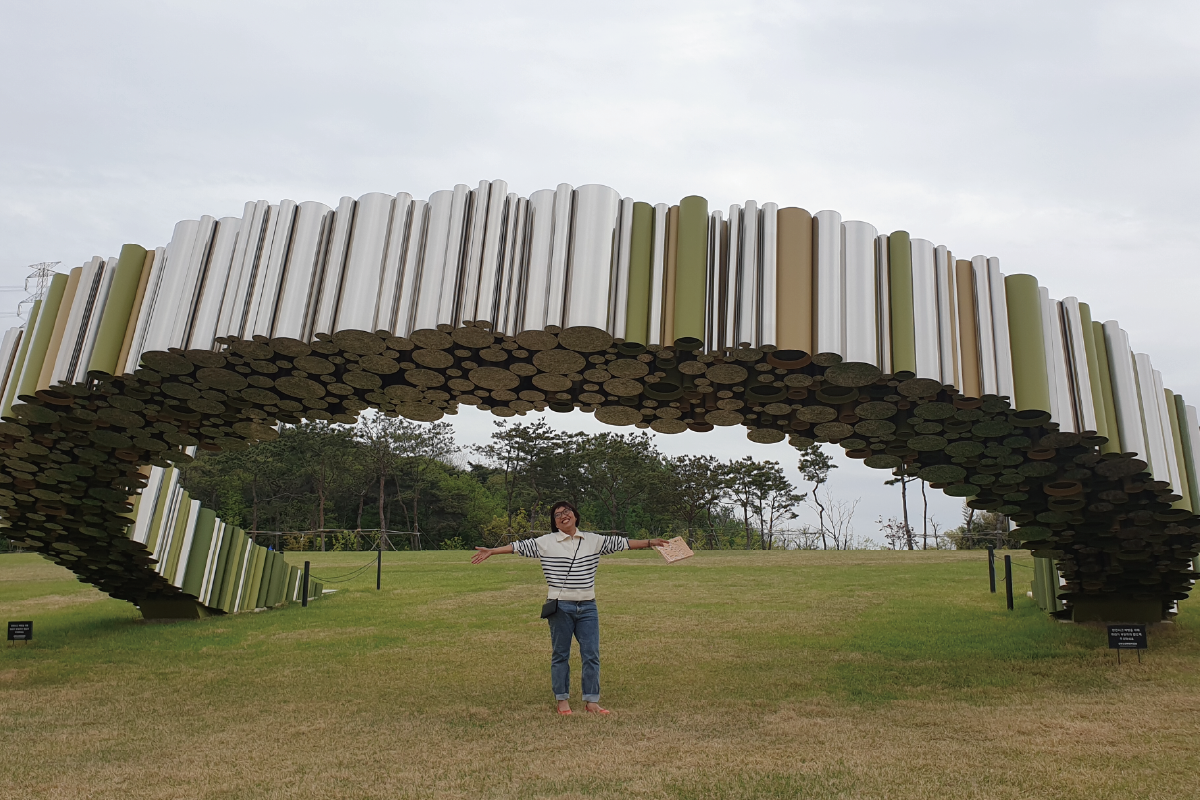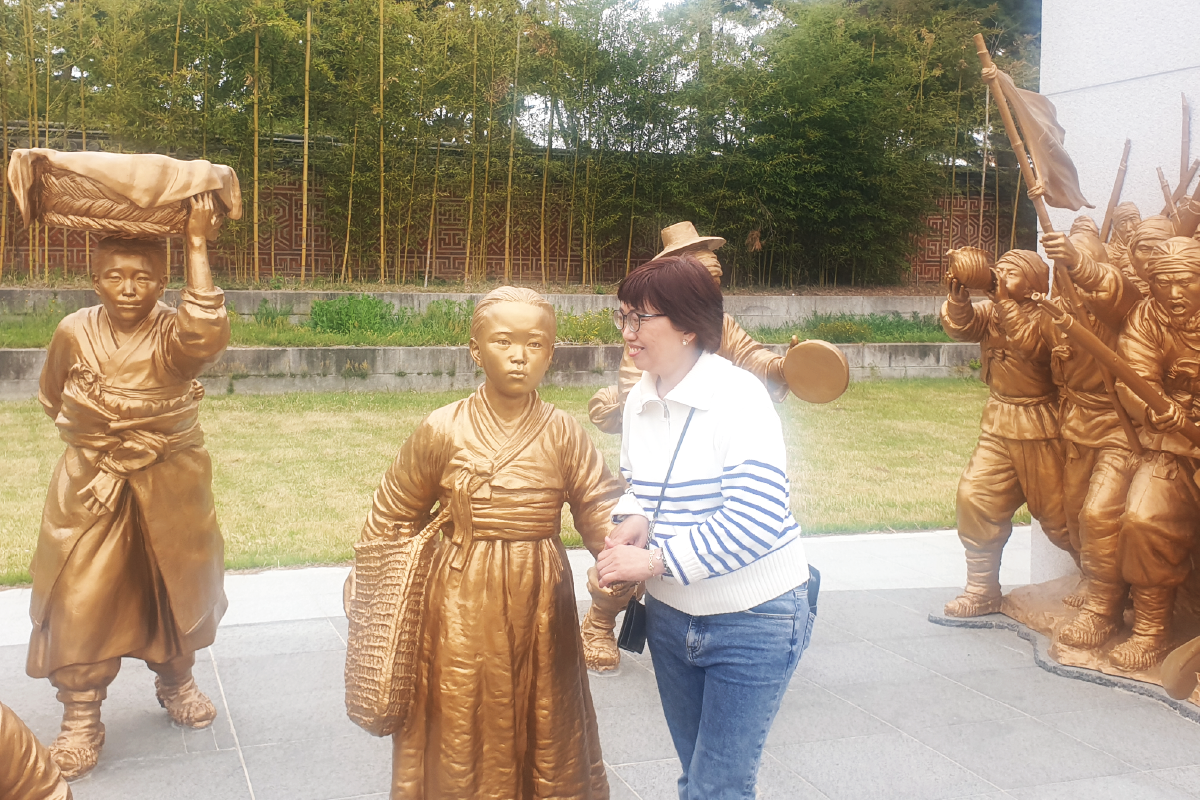
황토현에서 발린타왁(Balintawak)의 외침을 듣다
Listen the Cry of Balintawak in Hwangtohyeoun
리가아 글로비오 Ligaya Globio

리가아 글로비오 (Ligaya Globio)
필리핀 출신으로 13년 전 한국인과 결혼하여 이주한 여성이다. 현재 한국에서 영어 강사와 함께 유치원과 초등학교에서 다문화 이해 강사로 활동하고 있다.
Ligaya Globio
She was born in the Philippines. She married a Korean and moved to Korea 13 years ago. She is currently working as a multicultural awareness program instructor in kindergartens and elementary schools as well as an English academy teacher in Korea.
평범한 일요일 오후, 우리 가족은 여가생활을 위해 차를 몰고 정읍으로 향했습니다. 코로나 펜데믹으로 사람이 붐비는 내장산보다 다른 곳을 가보고 싶어서 인터넷으로 ‘정읍 가볼만한 곳’을 검색하여 그동안 한 번도 가보지 못한 동학농민혁명기념공원을 방문하였습니다. 기념공원에 도착하자마자 들었던 생각은 드넓으면서도 사람이 많지 않고, 아름다운 꽃들이 여기저기 피어 있어 산책하기 참 좋은 곳이라는 점이었습니다. 기념공원에서는 한국 전통음악이 흘러나왔고 조용하면서도 평화로웠습니다.
기념공원을 걷다가 호기심으로 기념공원 안에 자리한 동학농민혁명박물관으로 들어가 관람하였습니다. 박물관 내부의 분위기는 외부 분위기와 사뭇 달랐습니다. 박물관의 전시실에는 소용돌이치는 태평양 위에 여러 역사적 사건의 명칭들이 보이는 영상과 수많은 사진과 기록물이 전시되어 있었습니다. 나아가 동학농민혁명 전개 과정에 따른 여러 전투 상황, 그리고 희생된 참여자와 유족들의 고난을 보여주는 전시가 펼쳐져 있었습니다. 그중에서 저에게 가장 큰 감동을 안겨준 것은 “죽을 각오로 먼저 산에 올라오니, 그들은 무슨 의리가 있는 것이며 무슨 담력이 있는 것인가?”라는 문구였습니다.
박물관 관람을 통해 이곳(황토현전적)에서 농민들이 농기구와 죽창을 들고 관군과 맞서 싸워 대승을 거두었다는 사실과 이후 전주성을 점령하여 조선 정부와 협약(전주화약)까지 맺었다는 사실을 알고 경외감이 들었습니다. 기념공원과 기념관을 돌아보면서 저는 왠지 이 사건이 낯설지가 않았습니다. 왜일까? 생각하다가 문득 저의 조국 필리핀의 역사가 떠올랐습니다. 필리핀은 300년 넘게 지속된 스페인 식민통치에 저항해 1896년 ‘발린타왁(Balintawak)의 외침’이라는 필리핀 마닐라 전투가 있었습니다. 이 전투는 패배하였지만 이후 필리핀 혁명의 불씨가 되었습니다. 필리핀은 스페인에게 333년 동안 식민통치를 받았고, 이후 바로 미국에게 약 50년 간 식민통치를 받았습니다. 필리핀 국민들은 ‘발린타왁(Balintawak)의 외침’전투 이후 1946년 필리핀이 미국으로부터 독립할 때까지 지속적으로 독립투쟁을 전개하였는데, 그 투쟁을 ‘필리핀 혁명’이라고 부릅니다.
It was an ordinary Sunday afternoon and my family were driving to Jeongeup City for our weekend getaway. We dislike going to crowded places, an aftermath of the pandemic, so we avoided Mt. Naejang. Instead I searched the internet and typed " places to visit in Jeongeup" and found Donghak Peasant Revolution Memorial Park. We have never been there so we decided to go. We arrived and we found it a very good place for walk. The place is expansive, with few people around, beautiful flowers blooming here and there and very quiet and peaceful even with the traditional Korean instrumental music playing in the memorial park.
Out of curiosity, we roamed inside the Donghak Peasant Revolution Museum in the memorial park. The atmosphere inside the museum is surprisingly in contrast with the quiet mood outside. There was a virtual screen showing the names of many historic events swirling over the Pacific Ocean, also numerous photographs and documents were in the museum. Furthermore, there was an exhibition showing various battles leading to the development of the Donghak Peasant Revolution, the participants who sacrificed their lives and the hardships of their families and descendants. Then I saw this: "What courage and what loyalty do they have to climb the mountain and die there?" These are the words that struck me the most during my visit.
Through the tour in the museum, I was awed at the fact that the peasants fought against the government forces with bamboo spears and their farming tools and won a great victory here, and that they occupied Jeonju fortress and signed a peace agreement with the Joseon government. Wait a minute, why these events seem very familiar to me? Aha! It reminded me of a battle in Manila, the Phillipines called ‘The Cry of Balintawak’ in 1896 against the more than 300 years of Spanish colonization. The revolt was a failure on their first outbreak but it started the spark for the Philippine Revolution. The Philippines was colonized by Spain for 333 years, and then by the United States for about 50 years. Since the onset of the Cry of Balintawak, Filipinos continued to fight for independence until it gained independence from the United States in 1946, and the struggle is called the ‘Philippine Revolution’.

저는 필리핀에서 한국으로 이주하여 살고 있습니다. 저의 조국 필리핀의 역사와 겹쳐서인지 동학농민혁명기념공원에 있는 ‘불멸, 바람길’(전봉준 장군과 동학농민군 동상)을 보고 큰 감동을 받았습니다. 작품 속 죽창을 든 농민들이 함께하자고 저에게 손짓하는 것만 같았습니다. 동상 속의 농민들은 저처럼 평범하고 보잘것없는 존재였기 때문에 그 인물들이 더 가깝게 느껴졌던 것 같습니다. 그들은 부패하고, 불평등한 당시의 세상을 바꿀 수 있다는 꿈을 꾸었을 것입니다. 그들이 꿈꾼 세상은 낡은 봉건제도를 개혁하여 사람이 사람답게 살 수 있는, 인권이 존중되는 세상이었을 것입니다.
On a personal note, as an immigrant in Korea, I was emotional when I saw the statue of the Donghak peasants army in the park due to similar history between Korea and the Philippines. I felt like the peasants carrying bamboo spears were walking towards me and beckoning me to join them. I could almost feel them because they were like me, a nobody, yet they dreamt that they could change their world at that time. They dreamt of being able to change the corruption and inequality in their times. The world they dreamed of would have been a world where human rights were respected and where people could live like human beings by reforming the old feudal system.

동학농민군은 군사훈련도 받지 못했고, 그럴듯한 무기조차 없이 혁명에 나섰습니다. 저는 동학농민군이 열망했던 가치를 생각하면서 저의 조국 필리핀 선조들이 투쟁으로 이루고자 했던 것이 서로 같을 것이라는 점을 깊이 깨달았습니다. 동학농민혁명과 같은 혁명이 저의 조국 필리핀에도 있었다는 사실에 가슴이 뭉클하였습니다. 한국과 필리핀의 선조들은 서로 다른 시대, 다른 장소에서 싸웠지만 대의는 하나였던 것 같습니다.
동학농민혁명기념공원을 돌아보면서 저는 마치 조국 필리핀에 와있는 것처럼 유대감을 가질 수 있어 참 좋았습니다. 한국에서 보낸 13년 만에 저는 한국에서 조국 필리핀을 볼 수 있었습니다.
동학농민혁명의 영웅들에게 감사드립니다.
수고 많으셨습니다.
Donghak peasants army took the revolution without any military training and any plausible weapons, too. Thinking about the values that the Donghak Peasant Army aspired to, I deeply realized that my Filipino ancestors also tried to achieve and fought for the same ideals. I was touched by the fact that my country also has a revolution similar to the Donghak Peasant Revolution. Although the ancestors of Korea and the Philippines fought in different times, different places, but the cause was same.
While looking around the Donghak Peasant Revolution Memorial Park, I was very happy to have a feeling of connectedness with it as if I were in my homeland, the Philippines. After 13 years in Korea, I was able to see my country in Korea.
To the heroes of Donghak peasant revolution, thank you.
Thank you for your efforts.









